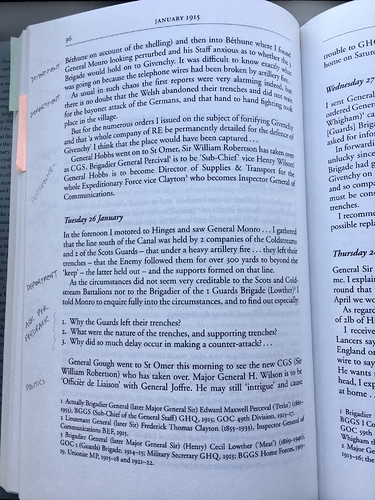@mwra This is very interesting, and shows the value of real examples. The “data” I tend to work with are about as different as they could be from yours. Looking at your work suggests to me that User Attributes will be less useful to me than $Tags (keywords!!), though I may live to revise that idea!
My own PhD (which I started at a very advanced age) was based on a close textual analysis of the war diaries of two British First World War generals: Douglas Haig and Henry Rawlinson. If memory seres me correctly I had something like 80,000 words of text for each year of the war. Conventional coding techniques for this sort of work involve writing a word in the left margin of the text indicating what is being talked about in that area of the text, and in the right margin you write something that says HOW the thing is being talked about. So, I might write “artillery” in the left margin and “ineffective because of dud shells” in the right margin. (There are computer programs to do this sort of thing, but at the time I was working I found them horribly unwieldy and slow. I actually did most of my work in Scrivener, which worked very well.) I have just dug out my paper copy of Haig’s diary, and although I finished the work six years ago and have forgotten a lot, I can still scan down the page and immediately see the main themes that are present in the diary entries. (See picture – no right margin comments here because of lack of space.)
So, for example, it became apparent that at a particular time of the war, one of the things that concerned Haig was what we decided to call “deportment” – how people carried themselves and behaved in all sorts of situations. So I extracted some passages that exemplified this, and quoted them in the thesis with a brief analysis of what Haig wrote.
I have moved on since I did the thesis, but I am still mainly interested in identifying themes and important concepts in texts. Having had these very useful discussions on the forum, it seems to me that this is more a job for $Tags (keywords) than it is for User Attributes. True, there might be a lot of sense in having a User Attribute for $Themes, but I haven’t yet worked out what might be gained or lost by separating $Themes from other keywords. In the first example I gave, it is not just the fact that the main theme is “artillery” that interests us: it is the fact that it is “artillery as ineffective because of dud shells” – which we might later compare with “artillery as ineffective because personnel poorly trained”. It occurs to me now that if we had a tag/keyword “artillery” and another “poor_training”, we could find notes where both keywords appear. But we could also find all instances of “poor_training”, whether of infantry, cavalry or whatever, and separately all instances of “artillery”, whether good, bad, indifferent, or whatever. On second thoughts, however, it might emerge that having a separate User Attribute for “training” could be useful, because you could give it a value of “good;bad;indifferent” and colour your notes accordingly(!)
In summary I think I’m inclining to the view that you have to listen to the data, and do what it tells you to do in response to whatever you are trying to find out from it. And the advantage of Tinderbox, from what I can tell, is that it will allow you to adapt as your understanding of your data develops. At one point in your research it might make sense to have $Tags, at another point it might make sense to have User Attributes because you can see categories emerging from a study of the data, then you might need to go back to $Tags again because you find the categories are too rigid for the material you are uncovering. Human behaviour and thought are particularly hard to pin down, and any “hard boundary” between one category and another is usually somewhat arbitrary, though some degree of categorisation is usually unavoidable. At the moment, therefore, I think I will have to use $Tags / keywords until such time as useful categories suggest themselves from what I am studying. At which point it should be relatively easy to add the relevant User Attributes.
